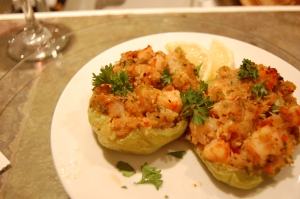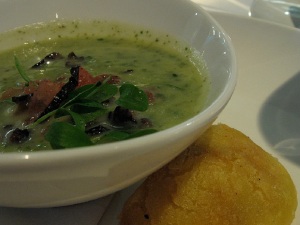 Today, I present another mystery Mesoamerica vegetable called Chayote. Cha-what? I know is a weird word, but easy to pronounce, chah-yoh-teh.
Today, I present another mystery Mesoamerica vegetable called Chayote. Cha-what? I know is a weird word, but easy to pronounce, chah-yoh-teh.
Chayote is originally native to Mesoamerica, but has been introduced as a crop worldwide. The main growing regions are Costa Rica and Veracruz, Mexico. Costa Rican chayotes are predominantly exported to the European Union whereas Veracruz is the main exporter of chayotes to the United States. Chroniclers from the time of the conquest record that, in Mexico at least; the chayote has been cultivated since pre-Columbian times. As regards linguistic references, the common names of native origin are concentrated mainly in Mexico and Central America. Exploration records concur in the finding that the widest variation of S. edule under cultivation is found between southern Mexico and Guatemala. The geographical distribution of the wild relatives of S. edule also testifies to the Mesoamerican origin of this crop.
 The Chayote is used mainly for human consumption. The fruit, stems and young leaves as well as the tuberized portions of the roots are eaten as a vegetable, both alone and plain boiled, and as an ingredient of numerous stews. Because of its softness, the fruit has been used for children’s food; juices, sauces and pasta dishes. In Mexico, an attempt has been made to increase the life of the fruit by drying it. The results have been positive and have enabled jams and other sweets to be prepared while also producing dried fruit which can be used as a vegetable after a certain time. Because of their flexibility and strength, the stems have been used in the craft manufacture of baskets and hats. In India, the fruit and roots are not only used as human food but also as fodder. S. edule is a perennial, monoecious climber, with thickened roots and slender, branching stems up to 10 m long. Its leaves are on sulcate petioles of 8 to 15 cm in length, they are ovate-cordate to suborbicular, measure 8 to 18 x 9 to 22 cm, are slightly lobate (with three to five angular lobes) and have minutely denticulate margins and three to five divided tendrils.
The Chayote is used mainly for human consumption. The fruit, stems and young leaves as well as the tuberized portions of the roots are eaten as a vegetable, both alone and plain boiled, and as an ingredient of numerous stews. Because of its softness, the fruit has been used for children’s food; juices, sauces and pasta dishes. In Mexico, an attempt has been made to increase the life of the fruit by drying it. The results have been positive and have enabled jams and other sweets to be prepared while also producing dried fruit which can be used as a vegetable after a certain time. Because of their flexibility and strength, the stems have been used in the craft manufacture of baskets and hats. In India, the fruit and roots are not only used as human food but also as fodder. S. edule is a perennial, monoecious climber, with thickened roots and slender, branching stems up to 10 m long. Its leaves are on sulcate petioles of 8 to 15 cm in length, they are ovate-cordate to suborbicular, measure 8 to 18 x 9 to 22 cm, are slightly lobate (with three to five angular lobes) and have minutely denticulate margins and three to five divided tendrils.
 The flowers are unisexual, normally pentamerous, coaxillary and with ten nectaries in the form of a pore at the base of the calyx. The staminate flowers grow in axillary racemose inflorescences that are 10 to 30 cm long, and the groups of flowers are distributed at intervals along the rachis. The calyx is patteliform and 5 mm wide, the sepals triangular and 3 to 6 mm long, the petals triangular, greenish to greenish-white and measure 4 to 8 x 2 to 3 mm. There are five stamens, and the filaments are fused almost along their total length, forming a thickened column which separates at the apex into three or five short branches.
The flowers are unisexual, normally pentamerous, coaxillary and with ten nectaries in the form of a pore at the base of the calyx. The staminate flowers grow in axillary racemose inflorescences that are 10 to 30 cm long, and the groups of flowers are distributed at intervals along the rachis. The calyx is patteliform and 5 mm wide, the sepals triangular and 3 to 6 mm long, the petals triangular, greenish to greenish-white and measure 4 to 8 x 2 to 3 mm. There are five stamens, and the filaments are fused almost along their total length, forming a thickened column which separates at the apex into three or five short branches.
Other warm regions around the globe have been successful in cultivating it as well. The main growing regions are Costa Rica and Veracruz, Mexico. Costa Rican chayotes are predominantly exported to the European Union whereas Veracruz is the main exporter of chayotes to the United States. The chayote fruit is used in both raw and cooked forms. When cooked, chayote is usually handled like summer squash; it is generally lightly cooked to retain the crisp flavor. Raw chayote may be added to salads or salsas, and it is often marinated with lemon or lime juice. Although the end stalks are tough, the tendrils can be eaten just like most leafy green vegetable. It can also be eaten straight, although the bland flavor makes this a dubious endeavor. Whether raw or cooked, chayote is a good source of amino acids and vitamin C.
 Malay Style Stir Fried Chayote Shoots with Dried Anchovies
Malay Style Stir Fried Chayote Shoots with Dried Anchovies
*wendyywy*
Ingredients
500gm chayote shoots
1 red chilli
½ onion, sliced
2 cloves garlic, peeled and lightly smashed, or just slice it
2 Tbsp dried anchovies (ikan bilis), rinsed
1 cup water
½ tsp salt
Instructions
Heat wok and put in 2 Tbsp cooking oil. Put in garlic and sliced onions and cook until garlic is slightly golden and fragrant. Put in chilli and dried anchovies. Fry for a while until the anchovies smell good. Put in chayote leaves and toss. When the chayote leaves look slightly wilted, put in water. Cook for 1-2 minutes and season with salt. Dish up.

Crab and Shrimp Stuffed Chayote
*duodishes.com*
Ingredients
2 medium sized Chayotes
4 tablespoons unsalted butter
1/2 medium yellow onion, chopped
1/2 small green bell pepper, chopped
1 stalk green onion, including white bits, sliced
1 stalk of celery, chopped
4 cloves garlic, minced
1 tomato, diced
1 tablespoon fresh parsley, chopped
1/2 teaspoon dried thyme
1 teaspoon Creole seasoning
1/3 pound cooked shrimp, peeled, deveined and coarsely chopped
1/4 cup raw pecans, chopped
6 ounces of crab meat
Salt, to taste
Black pepper, to taste
Instructions
Cut each of the squash in half lengthwise. Steam flesh side down for about 12-15 minutes or until center begins to soften. Set aside to let cool. Once cool enough to handle, use a spoon to scoop out most of the pulp, leaving about 1/4″ of the shell. Save the pulp and discard or save the seeds. In a large skillet, melt about 2 tablespoons of the butter and saute the onion, garlic, bell pepper, green onion and celery until tender, about 4-6 minutes. Stir in diced tomatoes, pulp from squash, herbs and Creole seasoning. Simmer for another 5-6 minutes. Season with salt and pepper. Blend in the shrimp and crab meat. Remove from heat and mix in nuts. Mound mixture generously into the squash shells and arrange in lightly greased baking dish. Melt remaining butter and drizzle over each squash. Bake uncovered in preheated 350 degrees for about 20 to 25 minutes, or until golden brown.
Ingredients
2 large Chayotes, peeled and sliced
2 onions, finely chopped
2 cloves garlic, chopped
1 potato, peeled and shredded
3 cups fat-free vegetable stock
salt and white pepper to taste
Garnish: slices of green onion and fresh squeezes of lime.
Instructions
Simmer chayote slices in 2 cups salted water in a medium saucepan until tender, about 20 minutes. Sauté onion and garlic in a large, non-stick saucepan until the onion is soft. Add the shredded potato and stir for a minute. Pour in vegetable stock, bring to a boil, and cook over medium heat for about 15 minutes, until thickened. Add the chayote and its cooking water to the stock, and using a hand (immersion) blender, puree the soup right in the pan. Stir and season to taste. Let simmer, uncovered, for about 5 more minutes. Garnish with black bean purée and fresh cilantro sprouts. Mmmm Dahling, simple deeeelishh!




























Yum! I was googling images of chayote to email to a friend when I stumbled upon this post. Both recipes look delicious, especially the soup.
I’ll be back to peruse more of your recipes.
By the way, my husband just made a delicious panamanian potato salad that included beet and chayote among other things.
I’m not a big potato salad fan, but this changed my mind. Potato… beet and chayote? Mmmm… sounds delicious! Would you like to share your recipe with me?
Thanks for stopping by my blog! Have a great day 🙂
Thanks for all the information on the chayote. We call this fruit christophene in Dominica. We use it mainly in soups and stews, and salads. I was unaware of the nutritional values. I used it in place of apples for apple pies and even american did not know that they were eating christophenes. I want to try using the leaves.
This fruit is very good for high blood pressure, and I am so glad to know of the amino acids in it. Thank you very much for the information.
Miss V.
I just tried my first chayote leaves and I love them. Very pleasant gentle taste.